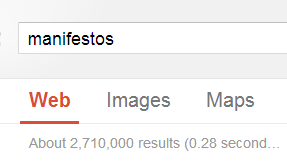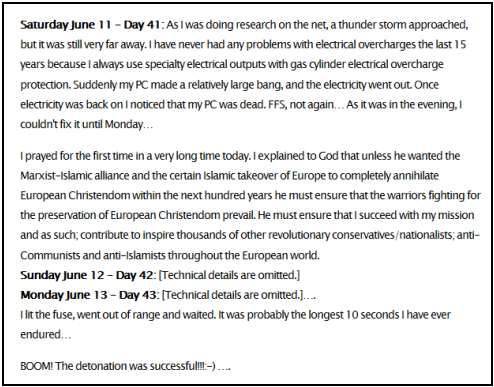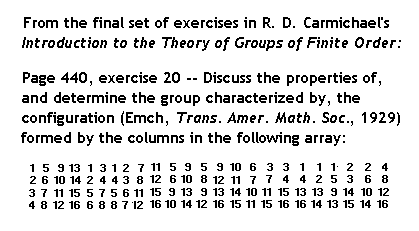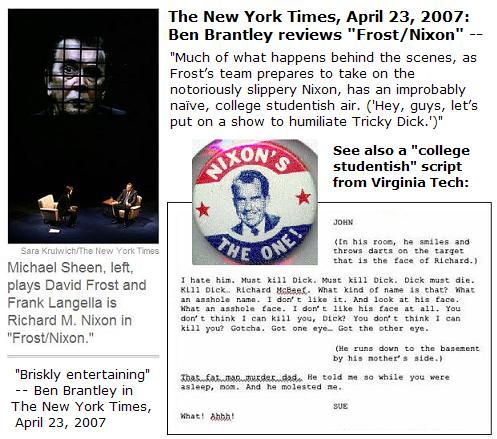
"These are not the examples most of us want to follow."

"These are not the examples most of us want to follow."
Some may prefer their own, less collective, manifestations.
Magic Mikes Continues:

"I get no kick from champagne…." — Cole Porter

See too another item with the BRC "Waking Dreams" date —
See 7/11, 2006.
Related material — Dabblers in the Collective Unconscious.
"Arnheim was a particularly important source
for Norway's principal architectural theorist,
Christian Norberg-Schulz."
— Andrew Peter Steen, University of Queensland
doctoral thesis, 2015
See
"Nine is a very powerful Nordic number."
— Katherine Neville, The Magic Circle
Venturi reportedly died on Tuesday, September 18.*
See also this journal on that date.
* Fact check:
"The four base units commute and satisfy
the multiplication table of the Klein 4 group."
— Bernd Schmeikal, article accepted
for publication on 11 April 2015
See also Log24 on 11 April 2015 (Orthodox Holy Saturday).
From the February 2016 article in the previous post —
"Over a century has passed since the publication,
in the Paris newspaper Le Figaro on 20 February 1909,
of a frontpage article by Filippo Tommaso Marinetti which
came to be known as the Manifesto of Futurism ."
This suggests a review of the 20 February 2009 posts now tagged

"Creation is the birth of something, and
something cannot come from nothing."
— Photographer Peter Lindbergh at his website
From a biography of Lindbergh —
"… it took Lindbergh awhile to find his true métier.
Born in Krefeld, Germany, in 1944….
Barely out of his teens, he became a painter who
embraced conceptual art and — for reasons he
has since forgotten — adopted the professional
name « Sultan. » Lindbergh… was a few years
short of his 30th birthday when he turned to
photography…."
— "The Man Who Loves Women," by Pamela Young,
Toronto Globe & Mail , September 19, 1996
A Lindbergh work (at right below) from his conceptual-art days —
For a connection between the above work by Paul Talman and the
above "Mono Type 1" of Lindbergh, see…
Here and at Catholics for Classical Education.
See also Tom Wolfe on manifestos —

— and part of an interesting Sept. 2, 2014, manifesto by
Common Core supporter Keith Devlin:
“Graduate students of mathematics are introduced to further
assumptions (about handling the infinite, and various other issues),
equally reasonable and useful, and in accord both with our everyday
intuitions (insofar as they are relevant) and with the rest of
mainstream mathematics. And on the basis of those assumptions,
you can prove that
1 + 2 + 3 + … = –1/12.
That’s right, the sum of all the natural numbers equals –1/12.
This result is so much in-your-face, that people whose mathematics
education stopped at the undergraduate level (if they got that far)
typically say it is wrong. It’s not. Just as with the 0.999… example,
where we had to construct a proper meaning for an infinite decimal
expansion before we could determine what its value is, so to we
have to define what that infinite sum means. ….”
For a correction to Devlin’s remarks, see a physics professor’s weblog post —
“From a strictly mathematical point of view,
the equation 1+2+3+4+ … = -1/12 is incorrect,
and involves confusing the Dirichlet series with
the zeta function.” — Greg Gbur, May 25, 2010
A 1911 essay by T. E. Hulme,
"Romanticism and Classicism" —
"There is a general tendency to think that verse means
little else than the expression of unsatisfied emotion.
People say: 'But how can you have verse without sentiment?'
You see what it is: the prospect alarms them. A classical revival
to them would mean the prospect of an arid desert and the death
of poetry as they understand it, and could only come to fill the gap
caused by that death. Exactly why this dry classical spirit should
have a positive and legitimate necessity to express itself in poetry
is utterly inconceivable to them."
A 1961 reaction against Hulme,
"Against Dryness" —
"Against the consolations of form, the clean crystalline
work, the simplified fantasy-myth, we must pit the
destructive power of the now so unfashionable naturalistic
idea of character.
Real people are destructive of myth, contingency is
destructive of fantasy and opens the way for imagination."
— Iris Murdoch, January 1961
Opening the Way —

For instances of character and imagination,
see this journal on February 8 and February 9.
See also the previous post and . . .
Academics may prefer "The Eureka Manifesto" —
From the MANIFESTO link in the Breakthrough Prize page above —
Our Mission . . . Should We Choose to Accept It
"A dark illimitable Ocean" — John Milton, Paradise Lost , Book II
"All is number" — Attributed to Pythagoras
|
"For a fraction of a second, Phocan senses |
From the MANIFESTO link in the Breakthrough Prize page above —
Our Mission . . . Should We Choose to Accept It
AI-assisted report on "Cullinane Diamond Theorem discovery" —

The full story of how the theorem was discovered is actually
a bit more interesting. See Art Space, a post of May 7, 2017,
and The Lindbergh Manifesto, a post of May 19, 2015.
"The discovery of the Cullinane Diamond Theorem is a testament
to the power of mathematical abstraction and its ability to reveal
deep connections and symmetries in seemingly simple structures."
I thank Bing for that favorable review.
Today's "Mrs. Davis" episode ends with Sister Simone
on a beach being sung to by a beachgoer choir.
This bizarre plot twist suggests some other images —
Also from March 8, 2020 —
The above Puchner remarks on the Communist Manifesto featured
a banner at the top crediting "California State University, Chico."
More recently, from this journal —
Besides "Mrs. Davis," this post was suggested by . . .
https://lareviewofbooks.org/article/
is-multiculturalism-an-oxymoron-on-martin-puchners-culture/ .
|
You, Xi-lin; Zhang, Peter. "Interality in Heidegger."
The term "interology" is meant as an interventional alternative to traditional Western ontology. The idea is to help shift people's attention and preoccupation from subjects, objects, and entities to the interzones, intervals, voids, constitutive grounds, relational fields, interpellative assemblages, rhizomes, and nothingness that lie between, outside, or beyond the so-called subjects, objects, and entities; from being to nothing, interbeing, and becoming; from self-identicalness to relationality, chance encounters, and new possibilities of life; from "to be" to "and … and … and …" (to borrow Deleuze's language); from the actual to the virtual; and so on. As such, the term wills nothing short of a paradigm shift. Unlike other "logoi," which have their "objects of study," interology studies interality, which is a non-object, a no-thing that in-forms and constitutes the objects and things studied by other logoi. |
Some remarks from this journal on April 1, 2015 —
Manifest O
|
| 83-06-21 | An invariance of symmetry The diamond theorem on a 4x4x4 cube, and a sketch of the proof. |
| 83-10-01 | Portrait of O A table of the octahedral group O using the 24 patterns from the 2×2 case of the diamond theorem. |
| 83-10-16 | Study of O A different way of looking at the octahedral group, using cubes that illustrate the 2x2x2 case of the diamond theorem. |
| 84-09-15 | Diamonds and whirls Block designs of a different sort — graphic figures on cubes. See also the University of Exeter page on the octahedral group O. |
The above site, finitegeometry.org/sc, illustrates how the symmetry
of various visual patterns is explained by what Zhang calls "interality."
Modernism, Fiction and Mathematics
by Nina Engelhardt
(Edinburgh Critical Studies in Modernist Culture)
From a review by Johann A. Makowsky in
Notices of the American Mathematical Society,
November 2020, pp. 1589-1595 —
"Engelhardt’s goal in this study is to put the interplay
between fiction and mathematical conceptualizations
of the world into its historical context. She sees her work
as a beginning for further studies on the role of mathematics,
not only modern, in fiction in the wider field of literature and
science. It is fair to say that in her book Nina Engelhardt does
succeed in giving us an inspiring tour d’horizon of this interplay."
Another such tour —

On the title of Westworld Season 4 Episode 5, "Zhuangzi" —

A song for Teddy: "Across my dreams, with nets of wonder . . ."
See Zhuangzi also in the 2022 Black Rock CIty manifesto, "Waking Dreams" . . .
From a book by Schultz, who reportedly died on Sept. 28:
Seeking continues (in this case, seeking the source) . . .
The previous post's link to posts tagged March 8, 2018,
suggests a look at recent thoughts by a Melbourne academic:
Manifesto in Green and Red
|
"Nor again will I pretend that, as Bacon asserts, `the pleasure and delight of knowledge and learning far surpasseth all other in nature'. This is too much the language of a salesman crying his own wares. The pleasures of the intellect are notoriously less vivid than either the pleasures of sense or the pleasures of the affections; and therefore, especially in the season of youth, the pursuit of knowledge is likely enough to be neglected and lightly esteemed in comparison with other pursuits offering much stronger immediate attractions. But the pleasure of learning and knowing, though not the keenest, is yet the least perishable of pleasures; the least subject to external things, and the play of chance, and the wear of time. And as a prudent man puts money by to serve as a provision for the material wants of his old age, so too he needs to lay up against the end of his days provision for the intellect. As the years go by, comparative values are found to alter: Time, says Sophocles, takes many things which once were pleasures and brings them nearer to pain. In the day when the strong men shall bow themselves, and desire shall fail, it will be a matter of yet more concern than now, whether one can say `my mind to me a kingdom is'; and whether the windows of the soul look out upon a broad and delightful landscape, or face nothing but a brick wall."
– A.E. Housman, Inaugural Lecture as Professor of Latin,
http://spenceralley.blogspot.com/2016/01/ |
(Continued … See “Is Fiction the Art of Lying?” by Mario Vargas Llosa,
a New York Times essay of October 7, 1984.)

"A non-fiction writer must have the freedom
to imagine the facts they [sic ] use."
Sure they must.
For the late Robert Venturi, who reportedly died on Tuesday, Sept. 18, 2018.
See also The Venturi Manifesto (Log24, Sept. 22, 2018).
"But unlike many who left the Communist Party, I turned left
rather than right, and returned—or rather turned for the first time—
to a critical examination of Marx's work. I found—and still find—
that his analysis of capitalism, which for me is the heart of his work,
provides the best starting point, the best critical tools, with which—
suitably developed—to understand contemporary capitalism.
I remind you that this year is also the sesquicentennial of the
Communist Manifesto , a document that still haunts the capitalist world."
— From "Autobiographical Reflections," a talk given on June 5, 1998, by
John Stachel at the Max Planck Institute for the History of Science in Berlin
on the occasion of a workshop honoring his 70th birthday,
"Space-Time, Quantum Entanglement and Critical Epistemology."
From a passage by Stachel quoted in the previous post —

From the source for Stachel's remarks on Weyl and coordinatization —

Note that Stachel distorted Weyl's text by replacing Weyl's word
"symbols" with the word "quantities." —

This replacement makes no sense if the coordinates in question
are drawn from a Galois field — a field not of quantities , but rather
of algebraic symbols .
"You've got to pick up every stitch… Must be the season of the witch."
— Donovan song at the end of Nicole Kidman's "To Die For"
From posts now tagged “Memory-History-Geometry” —
“… even the dogs under the table
eat the children’s crumbs.” — Mark 7:28
From a 2015 post …
“… Kansas and Harvard officially met
as Kansas wrestled the unsuspecting Harvard
to the ground in a headlock.”
— Harvard Heart of Gold , by Dustin Aguilar,
quoted here on April 24, 2015
For the dogs under the table, a note from that same date —
See as well Tom Wolfe on manifestos
and “the creative spirit.”
"May, / The months [sic ] of understanding" — Wallace Stevens
Saturday, May 21, 2016
|
|
"If pure mathematics does spring from sub-conscious intuitions— already deep-structured as are grammatical patterns in the transformational-generative theory of language?— if the algebraic operation arises from wholly internalized pattern-weaving, how then can it, at so many points, mesh with, correspond to, the material forms of the world?"
— Steiner, George. Grammars of Creation |
Good question.
See Bedtime Story (Sept. 1, 2016).
The previous three posts —
— suggest a review of a post from April 11, 2015:
Michael Starbird on Mathematics —
In Starbird's philosophical fable, the "fifth element" is change .
See also the recent post White Mischief.
"The Manifesto of Futurism Revisited" —
Related material — "Manifesto" in this journal —
more specifically, "Manifest O."
The phrase GET SPIKED BY EMAIL* above suggests a review of
"Something in the Way She Moves" and "Marissa and the Dropbox."
See also …
Marissa Mayer, not amused —

The cover of the K. O. Friedrichs book From Pythagoras to Einstein
shown in the previous post suggests a review (click the Log24
images for webpages where they can be manipulated) ….
The "more sophisticated" link in the first image above
leads to a webpage by Alexander Bogomolny,
"Pythagoras' Theorem by Tessellation," that says
"This is a subtle and beautiful proof."
Bogomolny refers us to the Friedrichs book, from which one of
the illustrations of the proof by tessellation is as follows —

For a quite different use of superposition, see
The Lindbergh Manifesto (May 19, 2015).
Illustration from The New York Times of the
book discussed in today's noon post , subtitled
Four Big Ideas and How
They Made the Modern World —
Related enumerative rhetoric: The Starbird Manifesto.
In memory of a woman who died on August 5th:
An excerpt from Svetlana Boym’s
For further remarks on art and technology,
see posts tagged Stevens Owl.
The previous post's link to The Lindbergh Manifesto
and Thursday's post on Basel-born artist Wolf Barth
suggest the following —
See as well a June 14 New York Times
piece on Art Basel.
The logo of the University of Basel …
… suggests a review of The Holy Field —
The title was suggested by
http://benmarcus.com/smallwork/manifesto/.
The "O" of the title stands for the octahedral group.
See the following, from http://finitegeometry.org/sc/map.html —
|
|
An invariance of symmetry The diamond theorem on a 4x4x4 cube, and a sketch of the proof. |
| 83-10-01 | Portrait of O A table of the octahedral group O using the 24 patterns from the 2×2 case of the diamond theorem. |
| 83-10-16 | Study of O A different way of looking at the octahedral group, using cubes that illustrate the 2x2x2 case of the diamond theorem. |
| 84-09-15 | Diamonds and whirls Block designs of a different sort — graphic figures on cubes. See also the University of Exeter page on the octahedral group O. |
The date at the end of yesterday’s noon post was May 25, 2010.
This, together with Keith Devlin’s Twitter page today, suggests
a review of that date.

Res ipsa loquitur.
See also…
Spelling Bee:
Manifesto I vs. Manifesto II—
I The Commonist Manifesto
II The Anti-Commonist Manifesto
Google's Choice:

The People's Choice:

In today's online New York Times , Roger Cohen quotes a manifesto—

A more complete excerpt—

Note that Cohen omits the concluding punctuation—
three exclamation points and a smile emoticon—
!!!:-)
(Compare and contrast with the smile of Hannibal Lecter.)
Related material from this journal on the following day, Flag Day, June 14—

Note that the structure of the central flag above |
See also the remark of author Siri Hustvedt (of Norwegian-American
background) that was quoted here Sunday.
From University Book Store, Seattle, Washington—

Related material—
|
The Use and Abuse |
From a page on Reality Hunger: A Manifesto at DavidShields.com—
"The book's epigraph is a statement from Picasso: 'All art is theft.'"
Update of 3 PM EDT April 7—
"… we get inspiration from everywhere, and there's a bright line between inspiration and slavish imitation. (I was going to throw in the Picasso quote 'All art is theft' here, but I've looked that up in both the Oxford Dictionary of Quotations (and the Oxford Dictionary of Modern Quotations
, just in case) and in the new Yale Book of Quotations
, and can't find it. So I'll just have to steal without the glamour of Picasso having said it was okay.)"
— Weblog post by Erin McKean
"Epistulae ad familiares" (adfamiliares for short) at livejournal.com—
"Prefatory notes evoke a Republic of Letters— or at least an academic support group— in which the writer claims membership. In fact, they often describe something much more tenuous, the group of those who the author wishes had read his work, offered him references, or at least given him the time of day. Hence they retain something of the literary— not to say fictional— quality of traditional poets' prayers." (Anthony Grafton, The Footnote: A Curious History)
P.S. This book rules. Why did I wait so long to read it?
* See a definition. See also this journal's previous post, Patterns in the Carpets. As for "those who the author wishes had read his work," see a quotation from an author mentioned in that post, Greg Egan, that seems relevant to the suicide outside Harvard's Memorial Church last Saturday during the morning Yom Kippur service—
… The word "transhumanism" (or, even worse, "posthumanism") sounds like a suicide note for the species, which effectively renders it a political suicide note for any movement by that name. No doubt there are people prepared to spend 90% of their time and energy explaining that they didn't intend any negative connotations, but this is not one of those cases where other people will be to blame if "transhumanists" are reviled as the enemies of humanity on purely linguistic grounds. It's no use people proclaiming "Please, read my 1,000-page manifesto, don't just look at one word!"….
— Greg Egan on April 23, 2008,** at Metamagician and the Hellfire Club
Related material— A livejournal note on the Memorial Church suicide, nihilism, and a "final crux."
** Footnote to a footnote— See also Log24 on April 23, 2008— Shakespeare's birthday.
From Braque's birthday, 2006:
"The senses deform, the mind forms. Work to perfect the mind. There is no certitude but in what the mind conceives."
— Georges Braque,
Reflections on Painting, 1917
Those who wish to follow Braque's advice may try the following exercise from a book first published in 1937:


For a different view
of the square and cube
see yesterday's entry
Abstraction and Faith.
The Revelation Game
New Year’s reading for
the tigers of Princeton
Two reviews from the February 2008 Notices of the American Mathematical Society:
From a review of
A Certain Ambiguity
(A Mathematical Novel)
by Gaurav Suri and Hartosh Singh Bal
Princeton University Press
Hardcover, US$27.95, 281 pages —
“From the Habermas-Lyotard debate (see [1] for an introduction) to the Sokal hoax ([4]), to recent atheist manifestos on the bestseller lists (e.g., [2]) the question of foundations for intellectual thought and especially for intellectual debate has never been more critical or urgent.”
[1] M. Bérubé, What’s Liberal about the Liberal Arts? Classroom Politics and “Bias” in Higher Education, W. W. Norton, 2006.
[2] S. Harris, Letter to a Christian Nation, Knopf, 2006.
[4] A. Sokal and P. Bricmont, Fashionable Nonsense: Postmodern Intellectuals’ Abuse of Science, Picador, 1999.
Also in the February Notices– a review of a book, Superior Beings: If They Exist, How Would We Know?, in which the author
“.. uses elementary ideas from game theory to create situations between a Person (P) and God (Supreme Being, SB) and discusses how each reacts to the other in these model scenarios….
In the ‘Revelation Game,’ for example,
the Person (P) has two options:
1) P can believe in SB’s existence
2) P can not believe in SB’s existence
The Supreme Being also has two options:
1) SB can reveal Himself
2) SB can not reveal Himself….
… [and] goals allow us to rank all the outcomes for each player from best… to worst…. The question we must answer is: what is the Nash equilibrium in this case?”
The answer is what one might expect from the American Mathematical Society:
“… the dominant strategy for both is when SB does not reveal Himself and P does not believe in His existence.”
Other strategies are, of course, possible. See last year’s entries.
See also
the life of John Nash,
for whom the above
equilibrium is named.

Above: PA Lottery on
Friday, November 16th,
the date of death
for noted leftist attorney
Victor Rabinowitz
“Mr. Rabinowitz was a member
of the Communist Party
from 1942 until the early 1960s,
he wrote in his memoir,
Unrepentant Leftist (1996).
He said the party
seemed the best vehicle
to fight for social justice.”
— The New York Times,
Nov. 20, 2007
Related material:
From the Harvard Crimson on Friday:
“Robert Scanlan, a professor of theater
who knew Beckett personally,
directed the plays….
He said that performing Beckett as part of
the New College Theatre’s inaugural series
represents an auspicious beginning.”
From Log24 on 4/19–
“Drama Workshop“–
a note of gratitude
from the Virginia Tech killer:
“Thanks to you, I die like Jesus Christ,
to inspire generations of the weak
and the defenseless people.”
“It’s not for me. For my children,
for my brothers and sisters…
I did it for them.”
Party on, Victor.
For further drama, see
On "framing" and "spin"
in journalism:
"… Packaging is unavoidable.
Facts rarely, if ever,
speak for themselves."
— Matthew C. Nisbet,
Assistant Professor
of "Communication,"
June 6, 2007
If they could, they might
say "We was framed!"
Facts cannot, of course,
speak for themselves
to those who do not
understand their language.
Example:
A picture that appeared in
Log24 on June 7, 2005:
Click for details.
Attempt to
frame the picture:
"A functor is an analogy."
— Anonymous
The best mathematicians "see
analogies between analogies."
— Banach, according to Ulam
For further details,
click on the link
"Analogies" above.
See also the analogies in
the previous entry.
Ben Brantley in this morning's New York Times:
"Television mows down a titan in 'Frost/Nixon,' the briskly entertaining new play by Peter Morgan* about the 1977 face-off between its title characters, the British talk show host (as in David) and the former American president (as in Richard M.)….
Structured as a prize fight between two starkly ambitious men in professional crisis, 'Frost/Nixon' makes it clear that the competitor who controls the camera reaps the spoils."

Another application of this
"control the camera" philosophy:
the multimedia manifesto of
the Virginia Tech author of
"Richard McBeef"
ART WARS continued…
|
|
 |
“The senses deform, the mind forms. Work to perfect the mind. There is no certitude but in what the mind conceives.”
— Georges Braque, Reflections on Painting, 1917
Those who wish to follow Braque’s advice may try the following exercise from a book first published in 1937:

Hint: See the above picture of
Braque and the construction of
a tesseract.
— Cynthia Zarin on Madeleine L’Engle,
“The Storyteller,” in The New Yorker,
issue dated April 12, 2004
The Shining of Apollo
"Plato's most significant passage may be found in Phaedrus 265b: 'And we made four divisions of the divine madness, ascribing them to four gods, saying that prophecy was inspired by Apollo, the mystic madness by Dionysos, the poetic by the Muses, and the madness of love […] by Aphrodite and Eros' (trans. by H.N. Fowler, in the Loeb Classical Library)."
— Saverio Marchignoli, note on section 20, paragraphs 115-119, of the Discourse on the Dignity of Man (Oratio de hominis dignitate) (1486) by Pico della Mirandola, considered the "Manifesto of the Renaissance."
Related material:
A Mass for Lucero,
The Shining of May 29,
Shining Forth,
Sermon for St. Patrick's Day, and the phrase
Diamond Struck by the Sun.
Matrix Theory
“At the heart of The Matrix, buried under layers of cinema craft, is a meditation on the difference between essence and appearance. It’s a trip into Plato’s cave.”
— McKenzie Wark, author of A Hacker Manifesto
Powered by WordPress